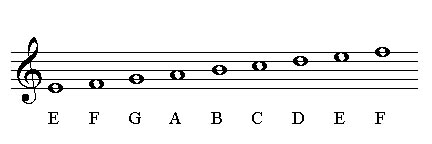
The study of how music works is called music theory. Music theory provides a way to think and talk about how musical sounds interact. It doesn’t explain every ounce of magic that makes music so awesome but it gives musicians skills to break down music into concepts, inspire creativity, and solve problems.
The musical alphabet is the starting point for learning how music works. The musical alphabet consists of 12 names we give to sounds that happen in most music. The easiest ones to understand are the first seven letters of the alphabet: A, B, C, D, E, F, & G. These are called “naturals”.
In addition to naturals, there are notes in-between A&B, C&D, D&E, F&G, G&A. There are no notes between B&C, or between E&F. The notes between the “natural” letters are called “sharps” or “flats”.
This seems crazy but there is a good reason. Having 7 naturals and 5 sharps/flats makes it so the piano is broken up into sections that the piano player can see and feel. If there were 6 naturals and 6 sharps/flats the piano would be an alternating pattern of black and white stripes.
Music can go very high or very low and we end up using more than the 12 sounds I’ve just described. What we do is move to another higher or lower group of the same 7 naturals and 5 sharps/flats. Once you get past the final note going upwards you get to the next A note and it all starts again.
It’s a complicated system but super valuable for musicians.
Practice saying the music alphabet going higher using the 7 natural notes:
A B C D E F G A B C D E F G A etc
Practice saying the music alphabet going lower using the 7 natural notes:
G F E D C B A G F E D C B A G etc
Memorize the 2 set of notes that don’t have a sharp/flat between:
B&C and E&F do not have a sharp/flat between them.
